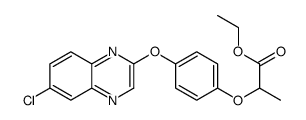quizalofop-ethyl

quizalofop-ethyl structure
|
Common Name | quizalofop-ethyl | ||
|---|---|---|---|---|
| CAS Number | 76578-14-8 | Molecular Weight | 372.80200 | |
| Density | 1.301 g/cm3 | Boiling Point | 503.9ºC at 760 mmHg | |
| Molecular Formula | C19H17ClN2O4 | Melting Point | 91.7-92.1ºC | |
| MSDS | Chinese USA | Flash Point | 100ºC | |
| Symbol |


GHS07, GHS09 |
Signal Word | Warning | |
|
Differential sensitivity of lipid metabolism in monocotyledons to grass-specific herbicides.
Biochem. Soc. Trans. 21(2) , 183S, (1993)
|
|
|
Use of plant cell cultures to study graminicide effects on lipid metabolism.
Phytochemistry 63(5) , 533-41, (2003) Graminicides belonging to the cyclohexanedione and aryloxyphenoxypropionate classes are well established to act by disrupting acyl lipid biosynthesis via specific inhibition of acetyl-CoA carboxylase. Species of grass inherently resistant to such herbicides, ... |
|
|
Effects of water management and herbicide treatments on red rice control.
Meded. Rijksuniv. Gent. Fak. Landbouwkd. Toegep. Biol. Wet. 67(3) , 441-9, (2002) Two field experiments were conducted in 1999 and 2000 at Zeme (Pavia, Italy) to determine the effects of water managements and herbicide treatments on red rice control. In the first experiment, all plots were flooded 10-13 cm deep from April 1 to May 17 in 19... |
|
|
Enantioselectivity in degradation and transformation of quizalofop-ethyl in soils.
Chirality 24(7) , 552-7, (2012) The enantioselective degradation of quizalofop-ethyl and its metabolite quizalofop-acid in two soils, a Wuhan acidic soil and a Baoding alkaline soil, was investigated. The dissipation of quizalofop-ethyl consisted of two phases, a rapidly deceasing first pha... |
|
|
Enzyme inhibitors to increase poly-3-hydroxybutyrate production by transgenic tobacco.
Biosci. Biotechnol. Biochem. 66(12) , 2537-42, (2002) Chemical regulation of secondary-metabolite synthesis was investigated through the improvement of poly-3-hydroxybutyrate (PHB) production in transgenic tobacco plants by the use of enzyme inhibitors. Two tobacco lines, BC3 and rCAB8, that produce PHB in both ... |
|
|
[Potential use of the herbicide quizalofop-p-ethyl for eicosapentaenoic acid overproduction by the diatom Nitzschia laevis].
Sheng Wu Gong Cheng Xue Bao 23(5) , 885-90, (2007) The diatom Nitzschia laevis is a good alternative source of eicosapentaenoic acid (EPA). Besides strategies for high cell density culture, EPA productivity may be further improved by herbicides. The effect of the herbicide quizalofop-p-ethyl on the growth and... |
|
|
Differential enantioselectivity of quizalofop ethyl and its acidic metabolite: direct enantiomeric separation and assessment of multiple toxicological endpoints.
J. Hazard. Mater. 186(1) , 876-82, (2011) Transformation products usually differ in environmental and toxicological properties compared to the parent contaminants, thus causing potential and unknown environmental risks. To elucidate differential chiral recognition of the aryloxypropanoate herbicide q... |
|
|
Development of an enzyme-linked immunosorbent assay for quantitative determination of quizalofop-p-ethyl.
J. Agric. Food Chem. 54(23) , 8682-7, (2006) Accurate quantification of quizalofop-p-ethyl is essential for it may do harm to humans and animals through both water and food. Currently, detection of quizalofop-p-ethyl mainly relies on methods such as gas chromatography, high performance liquid chromatogr... |
|
|
Characterization of racemization of chiral pesticides in organic solvents and water.
J. Chromatogr. A. 1217(36) , 5718-23, (2010) Eight chiral pesticides, which were selected to cover different pesticide species and origins of chirality, were investigated to explore their chiral stability in organic solvents and water. Profenophos, fenamiphos, quizalofop-ethyl, dichlorprop-methyl (DCPP-... |
|
|
Kinetics of the two forms of acetyl-CoA carboxylase from Pisum sativum. Correlation of the substrate specificity of the enzymes and sensitivity towards aryloxyphenoxypropionate herbicides.
Eur. J. Biochem. 225(3) , 1113-23, (1994) Steady-state kinetics of the 220-kDa form of acetyl-CoA carboxylase (ACC220), as purified from mature pea seeds, have been investigated with respect to the substrate specificity and inhibition by quizalofop, a herbicide of the aryloxyphenoxypropionate type. T... |